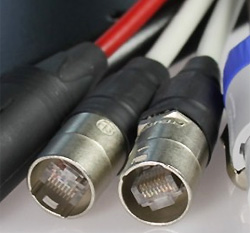
Transporting live audio signals in the digital domain has gone from unusual to common over the past few years, as digital consoles have become the norm, pro audio equipment is regularly outfitted with AES/EBU, optical, and Ethernet connectors for audio and control purposes, and pristine recordings are made on laptops via digital audio interfaces or direct from the console.
It’s now possible to network virtually all of the audio signal chain between the microphone or musical instrument and the loudspeakers – routing, processing, and mixing the signals digitally.
Taking audio from analog to digital allows multiple channels to be routed through a single optical fiber or Cat-5 (and Cat-5e/Cat-6) cable rather than using bulky, discrete copper cables for each channel. It’s possible to convert the signals from mics and instruments on stage at a high sample rate and not have to convert back to analog until they reach the loudspeaker array, all processed and mixed in the digital domain. Once in digital format, the audio signal is no longer subject to electromagnetic interference, frequency degradation from cable capacitance and similar losses. Buzzes and ground loops are a thing of the past.
Signals can be discretely routed and processed, and sent to multiple locations as needed. Changing where a particular signal appears on a digital console can be done via software rather than moving connectors to different physical inputs and outputs, and scenes and settings can be created offline and loaded into a digital console, ready for the next act. The same audio stream can be fed into a laptop to create a high-resolution recording.
The Field
Released in 1996, CobraNet (developed by Peak Audio and now offered by Cirrus Logic) was the first practical method for digitally networking and distributing professional audio signals. Because of the limitations of existing network technologies, including bandwidth, switching, and synchronization issues, proprietary algorithms were developed. CobraNet allows any audio input to be converted to digital and dynamically routed to any output over the Ethernet network, controlled via a software application.
With CobraNet, audio is “bundled” into groups of up to eight channels, which must remain together during transmission through the network. The maximum network capacity is a 100Mbps link, which can pass up to eight bundles (64 channels per node). Larger networks require multiple VLANs and switches. Though higher than the latest generation of digital audio networking that use TCP/IP methods, latency was still only a few milliseconds. CobraNet has been widely adopted, especially in fixed installation applications.
Digigram launched EtherSound in 2001, adopted in the field and licensed by manufacturers such as NEXO, Yamaha, DiGiCo, Crest Audio and others for use in products. ES-100 technology allowed up to 64 channels of low-latency, 24-bit/48 kHz digital audio plus control data to be distributed over a dedicated 100Mbps Ethernet network; the later ES-Giga routes up to 256 channels over a 1Gbps network.
EtherSound-enabled devices can be connected in a daisy-chain configuration without additional hardware, or in a star configuration with added Ethernet switches. Adding a connection between the first and last devices when daisy-chained creates a ring topology for redundancy, and there is no loss of audio if one of the interconnections is broken. The mapping of inputs and outputs is set with the EScontrol software application.
Optocore provides an open solution to transmitting digital audio and control signals over fiber and Cat-5, separately or in combination. The SANE protocol over Cat-5 transmits AES/EBU, MADI, and other digital audio streams. As a transmission system, Optocore has a low fixed latency of 41.6 microseconds, regardless of network bandwidth or the number of connected devices. Development of the technologies began in the early 1990s, with the first products launched in 1996, and Optocore remains influential, with digital converters and fiber modules widely in use.
Riedel Communications debuted the proprietary RockNet digital audio networking solution about a decade ago, offering up to 160 channels of 24-bit/48 kHz audio on a single Cat-5 cable, with up to 99 devices on a network—or 80 channels—at a 96 kHz sample rate. Latency is specified at 850 microseconds, from analog input to analog output, at 48 kHz. The system is typically set up in a ring topology for redundancy, and a variety of mic/line, digital, MADI, and mixing console interfaces are available, as well as fiber optic devices and in-line repeaters.

